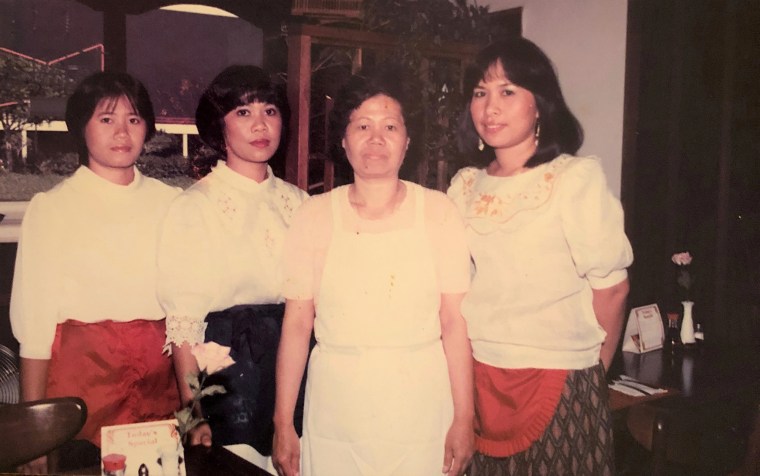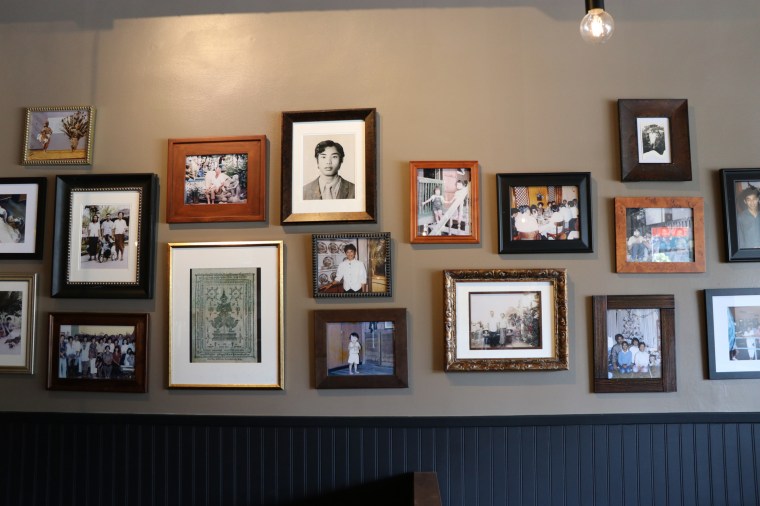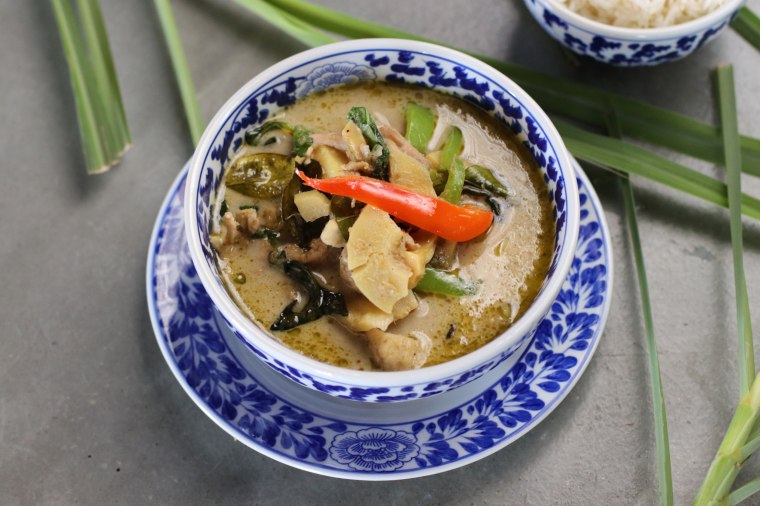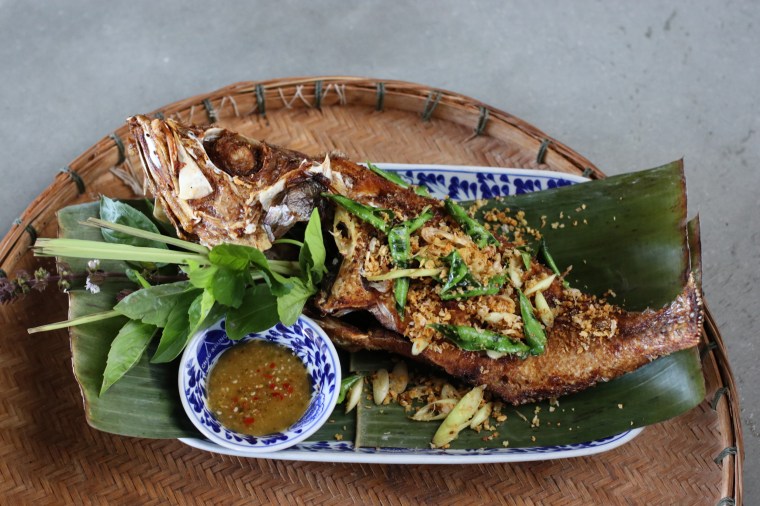LOS ANGELES — For Kris Yenbamroong, the timeline of Talesai — his family’s Thai eatery on the Sunset Strip in Los Angeles — is intimately tied with his own life: It opened its doors in 1982, the year he was born.
He has fond memories of spending afternoons and evenings as a child shuffling between the dining room and the kitchen where his grandmother prepped food for regular patrons of the restaurant, a favorite among entertainment industry types who came in — often with celebrities — for lunch and dinner.
“I would fall asleep in the office. At age 5 or 6, I remember I slept-walk[ed] into the dining room a couple of times during service,” Yenbamroong, 36, said with a laugh. During his summer breaks from studying film at New York University, he would work at the restaurant to make extra money, albeit with no intent of continuing the family business.
That is, until 2008. That was when, at the urging of his family, he took the reins of Talesai. Two years later, he opened his own restaurant, Night+Market, in a space next door to Talesai. The new restaurant eventually expanded and replaced the Sunset Strip Talesai.
Known for its spicy, West Coast-infused take on Thai staples, Night+Market now has three locations throughout the Los Angeles area, and Talesai has a location in the San Fernando Valley.
Yenbamroong, who does not have formal culinary training, was named Food & Wine Magazine’s Best New Chef in 2016. In 2017, he released a cookbook. Among his fans is actress Gwyneth Paltrow, who called Yenbamroong one of her “favorite chefs in the world.”
And like other second-generation Asian-American chefs, Yenbamroong is intent on putting his own spin on Thai culinary tradition.
“This is L.A. This isn’t Thailand. People are different, culture is different. It doesn’t make sense to me to have something exactly the way it is there,” he said.
Made by migration
Los Angeles is home to the only designated Thai Town in the United States and has the highest concentration of Thais in the country. According to the Thai Community Development Center, Thai migration to the U.S. dates back to the 1950s and expanded after the passage of the Immigration and Nationality Act of 1965, when national origin immigration quotas were eliminated to attract skilled labor and reunite immigrant families.
Following that, many immigrants from Thailand came as students, hungry not only for higher education opportunities but also craving food from their homeland, said Chanchanit Martorell, Thai CDC executive director and author of “Thais in Los Angeles.”
This led to what is known as the “Thai restaurant boom” of the 1970s and 1980s, largely concentrated in East Hollywood, where many Thai immigrants settled.
“The point of entry has always been East Hollywood because, back in Thailand, when they heard anything about the U.S., it was always about Hollywood and the entertainment industry,” Martorell said. She added that cheaper housing, compared to neighboring West Hollywood, was another motivating factor for Thai immigrants to settle there.
The opening of Bangkok Market in 1972 by owner Pramorte Tila (father of celebrity chef Jet Tila), where budding restaurateurs could shop for ingredients from Southeast Asia, was also crucial in facilitating L.A.’s Thai restaurant scene, according to Mark Padoongpatt, associate professor of Asian-American studies at the University of Nevada, Las Vegas, and author of “Flavors of Empire.”
Padoongpatt said the American love affair with Thai food can also be traced to an American woman named Marie M. Wilson. Wilson's husband was teaching English in Thailand on a Fulbright fellowship, Wilson, who accompanied him there, collected recipes for local cuisine, which she observed was a combination of Chinese and Indian food. Upon her return, she released “Siamese Cookery,” the first Thai cookbook published in the U.S., in 1965.
“The Thai food boom didn’t start just when Thai people set foot in Los Angeles. It was actually when the United States [went] abroad,” Padoongpatt said.
'It was a dead dining room'
Successfully marketing Thai food to the masses, though, was not an easy task during the early days of Chao Krung, one of the oldest Thai restaurants in L.A. Started in 1969 by the Kuntee family, head chef Supa Kuntee would include Chinese dishes to make the menu more palatable to non-Thai patrons, specifically at its locations outside of Thai Town.
“How did it feel to serve that? Not proud,” Kuntee’s daughter Katy Noochla-or said of watching her mother cook dishes like chow mein.

Noochla-or, 45, and her sister Amanda Kuntee, 44, have since taken over their family restaurant’s sole remaining location in L.A.’s Fairfax district. Last year, they revamped the menu to include even more traditional fare, such as khao soi (Chiang Mai curry noodles) and bek kai tod (fish sauce chicken wings). Kuntee makes curry pastes and sausage from scratch. Chow mein is no longer offered.
Like Yenbamroong, Kuntee didn’t intend to take over her family’s restaurant and, at one point, thought she would pursue a career in wardrobe styling. But she had been cooking with her family since childhood.
“When my grandma and grandpa would take care of us after school, they wouldn’t let us play outside. So, we stayed in, and they would cook,” Kuntee said.. “My first dish was green curry, my favorite. Just muddling, getting the coconut juice out. It was like playing but inside the house.”

Kuntee and Noochla-or have also been at the helm of several Thai restaurants in L.A., including Soi 56 and Chadaka Thai, both now shuttered. Noochla-or continues to operate Tuk-Tuk Thai in west L.A. and, in 2016, co-opened Same Same, a wine bar concept. So taking over Chao Krung from their parents was a natural fit for the sisters.
“I knew that my parents would never sell this restaurant. I knew that both of us would take over at some point. I was mentally prepared for it, and by the time I took over, I had already opened two or three,” Noochla-or said. They also credit Chao Krung’s continued success to customers’ changing palates, the celebrity chef culture, and access to ingredients commonly used in Thai cooking (palm sugar, dried shrimp).
“People’s taste buds are getting better and know Thai food better. It helps that restaurants are stepping up. It’s helping people to recognize that Thai food is not Chinese food,” Noochla-or said.
Like at Chao Krung, including more familiar Chinese food was a strategy Jazz Singsanong utilized when she first took over Jitlada in 2006 with her late brother, Chef Tui Sungkamee. Today, the understated southern Thai outpost — located in a nondescript strip mall on Sunset Blvd. — counts celebrities including Aziz Ansari, Drew Barrymore and Ryan Gosling as patrons. It’s not uncommon to see a queue of customers, many of whom are not Thai.
But in 2007, Jitlada was on the brink of closing.
“It was a dead dining room. It was one person at one table ordering chow mein or orange chicken,” said Tom Sopit, Singsanong’s nephew who would also help at the restaurant.
Sopit and Singsanong credit two incidents that ultimately saved Jitlada from shuttering: first, the translation of a “secret menu,” geared toward Thai Town locals, of spicy dishes originating from Singsanong’s hometown (Nakhon Si Thammarat) by a Chicago food blogger named “Erik M.”
Second, Pulitzer Prize-winning food writer Jonathan Gold, then writing for the L.A. Weekly, published his review, championing dishes such as sataw (stinky bean) and fish kidney curry. A week later, there was a line out the door.
It helped that, before Jitlada, Singsanong worked at a five-star hotel in Thailand. “I learned how to take care of your customers like your own family. I remember what they eat. I know what they order for lunch,” she said.
It’s the same philosophy Sopit remembers from his days being a waiter as a teenager and one he carries into new ventures as a restaurateur. Most recently, he opened the west coast location of international speakeasy Employees Only.
“If you’re coming to or from the kitchen, you always have to be holding something. Full hands in, full hands out. That was [Singsanong’s] rule,” Sopit said.
A fading legacy?
But second-generation chefs and restaurateurs willing to carry on the family legacy are getting increasingly rare, Thai CDC’s Martorell said.
“The second generation are becoming the professional class. They’re becoming the lawyers, the doctors, the engineers, the computer scientists, and accountants. And they don’t want to continue their parents’ business,” she said, citing an influx of older restaurant owners who have come to Thai CDC for advice on selling their businesses.
Padoongpatt agreed, but added that social media-driven foodie culture has also allowed chefs like Yenbamroong to flourish.
“Without foodie culture and without the rise of Yelp and this kind of backdrop, there really wouldn’t be any opportunity for them to enter into this field. But I think that opens up a chance to make a name for themselves. Kris is an example of that,” Padoongpatt said.

Carving out a niche comes with its own challenges, as Yenbamroong learned when he first took over Talesai. Within months, he canceled lunch service and cut 75 percent of the original menu in an effort to “try something new.” In the process, he lost longtime customers who didn’t hesitate to tell him how much they hated what they were seeing and tasting.
He said it wasn’t until he found the confidence to open Night+Market that he could fully express his culinary point of view with dishes such as Chiang Rai sausage (a nod to where his mother is from) and pad kee mao, made with pastrami from Langer’s, a James Beard award-winning deli in Los Angeles. The interiors of each Night+Market location are a reflection of the food, equal parts eclectic and colorful, with bright, citrus-colored walls.
“I’m not trying to do the encyclopedic Thai restaurant for everyone. I’m trying to do my very subjective view of this food, and a lot of this isn’t even Thai anymore,” Yenbamroong said. “I do me. I do me better than anyone else.”
Follow NBC Asian America on Facebook, Twitter, Instagram and Tumblr.

